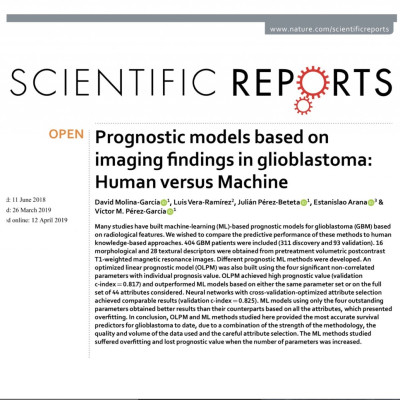Publication
Prognostic models based on imaging findings in glioblastoma: Human versus Machine
D. Molina-García, L. Vera, J. Pérez-Beteta, E. Arana, V.M. Pérez-García
Scientific Reports 9:5982 (2019)
MOLAB authors
Abstract
Many studies have built machine-learning (ML)-based prognostic models for glioblastoma (GBM) based on radiological features. We wished to compare the predictive performance of these methods to human knowledge-based approaches. 404 GBM patients were included (311 discovery and 93 validation). 16 morphological and 28 textural descriptors were obtained from pretreatment volumetric postcontrast T1-weighted magnetic resonance images. Different prognostic ML methods were developed. An optimized linear prognostic model (OLPM) was also built using the four significant non-correlated parameters with individual prognosis value. oLpM achieved high prognostic value (validation
c-index = 0.817) and outperformed ML models based on either the same parameter set or on the full
set of 44 attributes considered. Neural networks with cross-validation-optimized attribute selection achieved comparable results (validation c-index = 0.825). ML models using only the four outstanding parameters obtained better results than their counterparts based on all the attributes, which presented overfitting. In conclusion, OLPM and ML methods studied here provided the most accurate survival predictors for glioblastoma to date, due to a combination of the strength of the methodology, the quality and volume of the data used and the careful attribute selection. the ML methods studied suffered overfitting and lost prognostic value when the number of parameters was increased.















